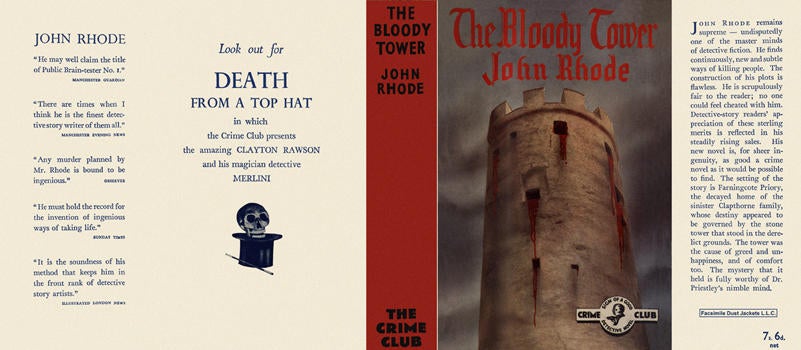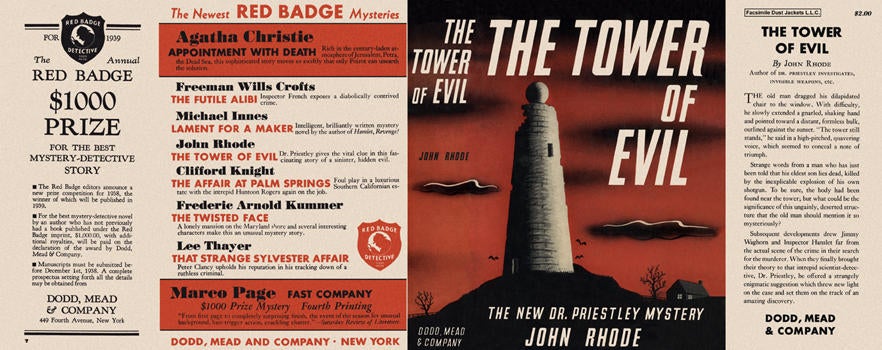St. Swithin Press, 2013. Book Format: Kindle Edition. File Size: 944 KB. Print Length: 220 pages. ASIN: B00D30B0Y4. ISBN: 978-1-927716-38-0. The Bloody Tower is a 1938 detective novel by John Rhode, the pen name of the British writer Cecil Street. It is the twenty ninth in his long-running series of novels featuring Lancelot Priestley, a Golden Age armchair detective. First published in the UK by Collins The Crime Club in 1938, it was published in the United States the same year by Dodd Mead & C0 under the alternative title The Tower of Evil. It is notable amongst Rhode’s more realistic style during the series, for its Gothic elements. For The Guardian E. R. Punshon wrote “in The Bloody Tower Mr. John Rhode gives another excellent example of his eminently satisfactory and solid talent.”
 Product Description: The old man dragged his dilapidated chair to the window. With difficulty, he slowly extended a gnarled, shaking hand and pointed toward a distant, formless bulk outlined against the sunset. “The tower still stands,” he said in a high-pitched, quivering voice, which seemed to conceal a note of triumph.
Product Description: The old man dragged his dilapidated chair to the window. With difficulty, he slowly extended a gnarled, shaking hand and pointed toward a distant, formless bulk outlined against the sunset. “The tower still stands,” he said in a high-pitched, quivering voice, which seemed to conceal a note of triumph.
Strange words from a man who has just been told that his eldest son lies dead, killed by the inescapable explosion of his own shotgun. To be sure, the body had been found near the tower, but what could be the significance of this ungainly structure that the old man should mention it so mysteriously? Could the key exist within the old letter bearing biblical citations alongside a cipher of odd, hand-drawn shapes.
Subsequent developments draw Jimmy Waghorn and Inspector Hanslet far from the actual crime scene in their search for the murderer. When they finally bring their theory to that intrepid scientist-detective, Dr. Priestley, he offers a strangely enigmatic suggestion which throws new light on the case and sets them on the track of an amazing discovery.
Synopsis: “The crumbling Farningcote Priory has been the home of the Glapthorne family for generations. In the grounds stand a tower, built as a folly during the eighteenth century which seems to have a strange, almost mystical power over the family. When Caleb Glapthorne is killed in what at first appears to be a shooting accident, it soon proves to be murder. Yet Inspector Jimmy Waghorn, in the area on the trail of a gang of thieves but called in to assist, fails to find any obvious motive. In the end he turns to Priestley to track down the vital clues.” (Wikipedia)
My Take: Cecil John Charles Street is, along with Freeman Wills Crofts and Alfred Walter Stewart, one of three British authors examined in depth by Curtis Evans in his book Masters of the “Humdrum” Mystery (McFarland & Co Inc, 2012). Of the three, John Street is probably the one who, jealous of his privacy, was the one about whom the least details of his private life were known until relatively recently.
On the other hand, some of John Street’s books are extremely difficult to find and The Bloody Tower is indeed one of them. If we add to this that, according to Curtis Evans, it is one of John Street’s most important novels, written under the John Rhode moniker, it is easy to understand my interest in this book, and it has not disappointed me in the least.
That said, I don’t have much more to add to the Wikipedia synopsis, since I don’t want to give much more away. Perhaps it is enough to highlight that the figure of Dr Priestley makes his appearance relatively late during the course of the narrative and his main function in the story will be to act as a simple armchair detective who will limit himself to showing the way to unmask the real culprit.
To finish I would just like to make TomCat’s words my own, when he writes in his review: “The Bloody Tower stands as one of Rhode’s better and most readable detective novels. A sobering, realistic take on the atmospheric, Gothic-style mysteries of doomed families and old, long-lingering curses laced together with an ingenious historical plot-thread. I unhesitatingly recommend it to everyone and particular to readers who are new to Rhode. You might not get to know Dr Priestley, but it shows, in more ways than one, what Rhode could do with the detective story.”
The Bloody Tower has been reviewed, among others by Curtis Evans at “The Passing Tramp”, Steve Barge at “In Search of the Classic Mystery Novel”, TomCat at “Beneath the Stains of Time” and Nick Fuller at “The Grandest Game in the World”.
 (Source. Facsimile Dust Jackets, LLC)
(Source. Facsimile Dust Jackets, LLC)
 (Source. Facsimile Dust Jackets, LLC)
(Source. Facsimile Dust Jackets, LLC)
About the Author: John Rhode was one pseudonym used by the prolific English author Cecil John Charles Street who also wrote as Miles Burton and Cecil Waye. Cecil John Charles Street, MC, OBE, (1884 – 1964), also known as CJC Street and John Street, began his military career as an artillery officer in the British army. During the course of World War I, he became a propagandist for MI7, in which role he held the rank of temp Major. After the armistice, he alternated between Dublin and London during the Irish War of Independence as an Information Officer for Dublin Castle. Street went on to become a prolific writer of detective novels when, in 1924, he published a thriller under the name of John Rhode and, by the end of the decade, he had already established himself as a prime candidate for founder-membership of the Detection Club. Only after his death did it emerge that Miles Burton was also a pen-name for Cecil John Street. And his flair for remaining a man of mystery was underlined when, as late as 2003, it was revealed by the Golden Age expert and researcher Tony Medawar that in the early Thirties Street had also written four obscure mysteries under the name Cecil Waye featuring ‘London’s most famous private detective’, Christopher Perrin.
Between 1924 and 1961 Street published a total of 144 novels, seventy-seven as John Rhode, sixty-three as Miles Burton and four as Cecil Waye. Under the name of John Rhode he produced a long series of novels featuring the forensic scientist Dr Priestley (72 books) and, as Miles Burton, he penned another long series featuring the investigator Desmond Merrion (61 books). The Dr Priestley novels were among the first after Sherlock Holmes to feature scientific detection of crime, such as analysing the mud on a suspect’s shoes. Desmond Merrion is an amateur detective who works with Scotland Yard’s Inspector Arnold. Under the name of Cecil Waye, Street produced four novels: Murder at Monk’s Barn (1931), The Figure of Eight (1931), The End of the Chase (1932) and The Prime Minister’s Pencil (1933).
Critic and author Julian Symons placed John Rhode as a prominent member of the “Humdrum” school of detective fiction. “Most of them came late to writing fiction, and few had much talent for it. They had some skill in constructing puzzles, nothing more, and ironically they fulfilled much better than S. S. Van Dine his dictum that the detective story properly belonged in the category of riddles or crossword puzzles. Most of the Humdrums were British, and among the best known of them were Major Cecil Street, who used the name of John Rhode, ….” Symons’ opinion has not however prevented the Rhode and Burton books becoming much sought after by collectors, and many of the early ones can command high prices. Jacques Barzun and Wendell Hertig Taylor in their A Catalogue of Crime offer a different perspective to Symons, praising several of the Rhode books in particular, though they only review a small proportion of the more than 140 novels written by Street.
Curt Evans has written the only detailed account of Street’s life and works: “I wrote my new book, Masters of the “Humdrum” Mystery: Cecil John Charles Street, Freeman Wills Crofts, Alfred Walter Stewart and the British Detective Novel, 1920–1961 (published by McFarland Press) in part to give a long overdue reappraisal of these purportedly “humdrum” detection writers as accomplished literary artists. Not only did they produce a goodly number of fine fair play puzzles, but their clever tales have more intrinsic interest as social documents and even sometimes as literary novels than they have been credited with having.” (Source: Wikipedia and others)
Most of John Rhode’s mystery novels are hard to find, but Mysterious Press/Open Road Media, to my knowledge, has so far published: The Paddington Mystery (1925); Dr Priestley Investigates (1930); Peril At Cranbury Hall (1930); Tragedy On the Line (1931); The Claverton Affair (1933); The Venner Crime (1933); Death in Harley Street (1945) and Blackthorn House (1949).
Among the 72 novels featuring Dr Priestley, according to Curtis Evans, those most notable are: The House on Tollard Ridge (1929), The Davidson Case (1929), The Claverton Mystery (1933) aka The Claverton Affair, The Venner Crime (1933), The Robthorne Mystery (1934), Poison for One (1934), Shot at Dawn (1934), The Corpse in the Car (1935), Death on the Board (1937) aka Death Sits on the Board, The Bloody Tower (1938) aka The Tower of Evil, They Watched by Night (1942), Vegetable Duck (1944), Death on Harley Street (1945).
Some other titles that might be worth reading are: Dr Priestley Investigates (1930) aka Pinehurst, The Hanging Woman (1931), Dead Men at the Folly (1932), The Motor Rally Mystery (1933) aka Dr Priestley Lays a Trap, Hendon’s First Case (1935), Mystery at Olympia (1935) aka Murder at the Motor Show, Proceed with Caution (1937), Invisible Weapons (1938), Death on the Boat Train (1940), Death at the Helm (1941), Dead on the Track (1943), Men Die at Cyprus Lodge (1943), Blackthorn House (1949), Death at the Inn (1953) and Licensed For Murder (1958).
St. Swithin Press publicity page
The Eventful Life of Cecil John Charles Street
